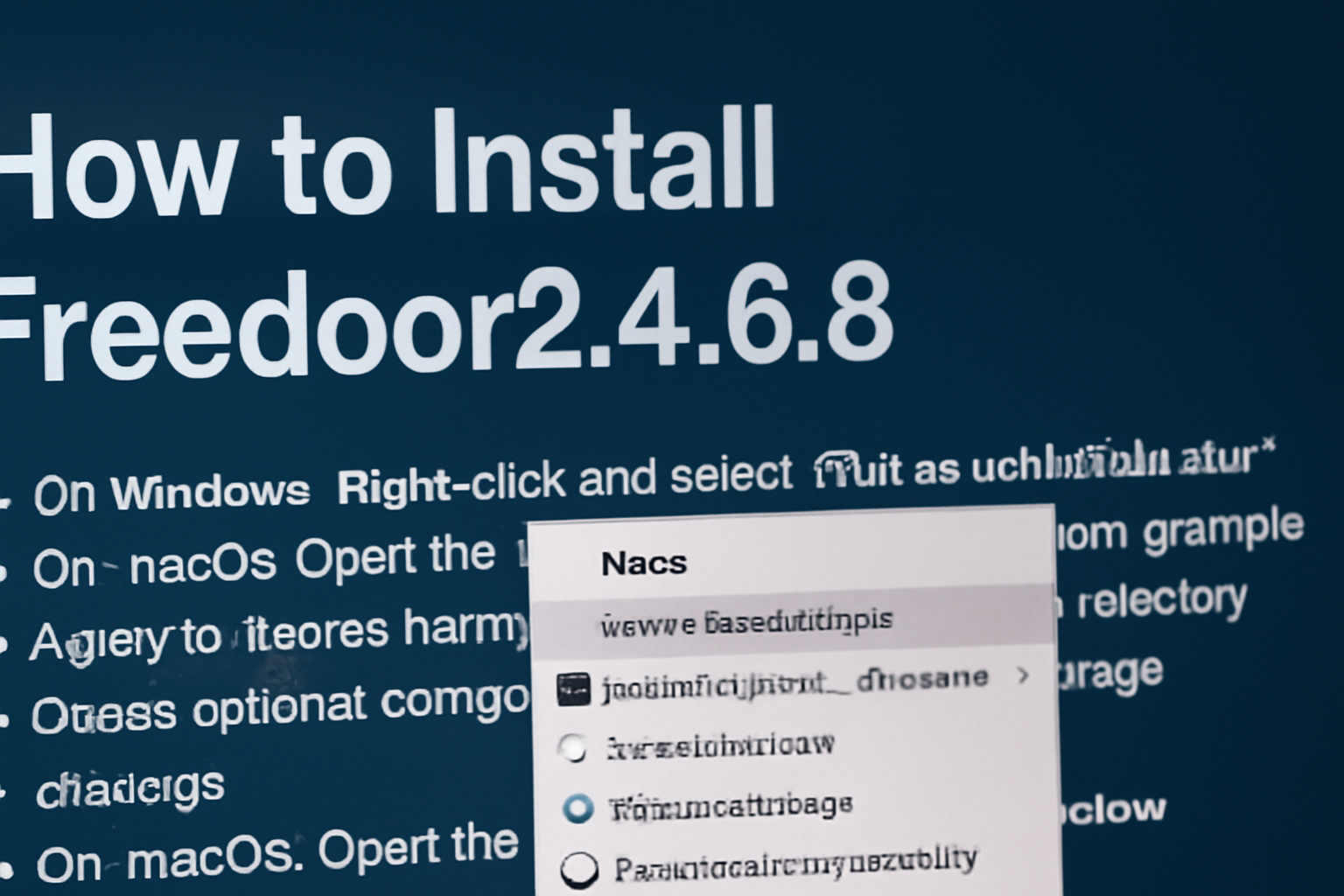Installing Freedoor2.4.6.8 doesn’t have to be daunting. In this guide, you’ll find clear, action‑oriented steps, troubleshooting advice, and useful tips to ensure success. Whether you are a beginner or an advanced user, this tutorial will walk you through the entire process.
Table of Contents
- System Requirements
- Pre‑Installation Checklist
- Download Freedoor2.4.6.8
- Prepare Installation Environment
- Run the Installer
- Post‑Installation Configuration
- Troubleshooting Common Issues
- Uninstallation Guidance
- Security Considerations
- Performance Optimization Tips
- FAQ
- Conclusion
1. System Requirements
Before starting, verify that your system meets the minimum specs. Freedoor2.4.6.8 requires:
- Operating System: Windows 10/11 or macOS 12+
- Processor: 2 GHz dual‑core or higher
- Memory: At least 4 GB RAM
- Disk Space: Minimum 500 MB free space
- Environment: .NET Framework 4.8 (for Windows) or Java JRE 11+ (for macOS)
Ensuring compatibility here can prevent installation errors later.
2. Pre‑Installation Checklist
Before you proceed, complete the following:
- Back up existing configurations and project files
- Disable conflicting software (e.g., older Freedoor versions or antivirus)
- Ensure administrator privileges are available
- Confirm stable internet connection
By preparing in advance, you avoid interruptions during installation.
3. Download Freedoor2.4.6.8
To download the installer:
- Visit the official Freedoor website
- Navigate to the “Downloads” section
- Locate the Freedoor2.4.6.8 installer package
- Click “Download” and save it to your local directory
Always use the official source to avoid corrupted or tampered files.
4. Prepare Installation Environment
Once downloaded:
- Verify file integrity: Compare the checksum (MD5/SHA256) with the website’s hash
- Use a clean folder: Place the installer in a dedicated folder (e.g.,
C:\FreedoorInstall) - Disable antivirus temporarily: This ensures no interference during installation
These measures help guarantee a smooth installation experience without interruptions.
5. Run the Installer
Now you’re ready to install:
- On Windows: Right‑click and select “Run as administrator”
- On macOS: Open the
.dmgor.pkgfile, then follow prompts - Agree to license terms and choose installation directory
- Select optional components as needed (e.g., language packs, extras)
- Click “Install” and wait until completion
This step installs Freedoor and its core modules automatically.
6. Post‑Installation Configuration
After installation:
- Launch Freedoor2.4.6.8 from the Start menu or Applications folder
- Complete setup wizard, entering license key if required
- Adjust preferences: UI language, default directories, and plugins
- Run initial update check within the application
By finishing these steps, your Freedoor installation will be fully optimized and ready for use.
7. Troubleshooting Common Issues
| Issue | Solution |
|---|---|
| Installer won’t start | Ensure admin rights and disable antivirus |
| Checksum mismatch | Re‑download from official source |
| Missing dependencies | Install .NET 4.8 or JRE 11 as required |
| Launch errors | Reinstall or run in compatibility mode |
If problems persist, consult Freedoor support forums or official documentation.
8. Uninstallation Guidance
If needed, you can remove Freedoor2.4.6.8:
- Windows: Use Control Panel → Programs & Features → Uninstall Freedoor
- macOS: Drag application to Trash and delete support files in
~/Library - Optionally, clean registry entries (Windows) or residual files manually
Clean uninstallation ensures no leftover files affect future installs.
9. Security Considerations
Boost your Freedoor setup by:
- Running updates to stay current with patches
- Configuring firewall rules to limit network access
- Regularly backing up project files and settings
- Reviewing plugin sources carefully before installation
These best practices help maintain a secure environment.
10. Performance Optimization Tips
To enhance Freedoor performance:
- Increase memory allocation via settings (e.g., JVM heap)
- Disable unused plugins to free resources
- Use SSD for faster load times
- Consider enabling multi‑threading if supported
These tips help Freedoor run smoothly, even with large projects.
11. Frequently Asked Questions (FAQ)
Q1: Is Freedoor2.4.6.8 free to use?
Yes. It’s available under a permissive open-source license for personal and commercial use.
Q2: Does it support plugins?
Absolutely. You can install community or commercial plugins from within the app.
Q3: Can I install it alongside older Freedoor versions?
Yes, if different folders are used. Just avoid shared configuration files.
Q4: What platforms does freedoor2.4.6.8 support?
Windows 10/11 and macOS 12+; Linux support may be community‑provided.
Q5: Where do I find logs?
Logs are located in C:\Users\<username>\AppData\Roaming\Freedoor\logs on Windows and ~/Library/Logs/Freedoor/ on macOS.
Q6: How do I update from an older version?
Run the installer over your existing setup or use in‑app update feature after backing up data.
12. Conclusion
You’ve now mastered how to install freedoor2.4.6.8. By following this detailed guide, you ensured compatibility, configuration, security, and optimal performance. If questions arise, consult Freedoor’s official documentation or vibrant community forums.












Leave a Reply